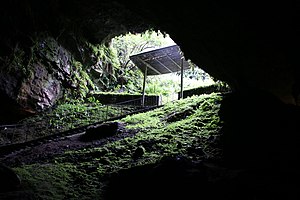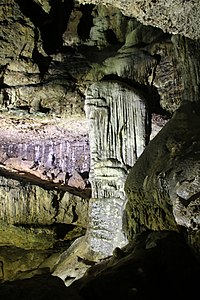Dunmore Cave: Difference between revisions
Created page with "{{Infobox cave |name=Dunmore Cave |irish=Dearc Fearna |county=Kilkenny |picture=Entrance to Dunmore Cave.jpg |picture caption=The entrance to Dunmore Cave |os grid ref=S50965..." |
|||
| Line 34: | Line 34: | ||
The earliest historical reference to the cave is to be found in the Triads of Ireland, dating from the 14th to the 19th century, where "|Úam Chnogba'', ''Úam Slángae'' and ''Dearc Fearna" are listed under the heading, "the three darkest places in Ireland".<ref name=triads-CELT>{{cite book| editor1-last=Meyer| editor1-first=Kuno| editor2-last=Lavelle| editor2-first=Hilary| editor3-last=Purcell| editor3-first=Emer|display-editors=3 | editor4-last=Färber| editor4-first=Beatrix | title=The Triads of Ireland| year=2005| edition=1st| publisher=Hodges, Figgis & Co| location=Dublin| series=Todd Lecture Series| volume=13| url=http://www.ucc.ie/celt/published/G103006/| accessdate=2010-11-06}}</ref> The last, meaning the "Cave of the Alders," is generally thought to be the present Dunmore Cave,<ref name=coleman/> while the first two translate as the caves of [[Knowth]] and Slaney.<ref name=triads-scan>{{cite book| editor-last=Meyer |editor-first=Kuno |title=The Triads of Ireland| edition=1st| publisher=Hodges, Figgis & Co| location=Dublin| year=1906| series=Todd Lecture Series| volume=13| pages=[https://archive.org/details/triadsofireland00meyeuoft/page/n25 4]–5| url=https://archive.org/details/triadsofireland00meyeuoft| accessdate=2010-11-06}}</ref> It is not known which exact system of caves/passage tombs near the river [[Slaney]] is being referred to, with the most likely, those at [[Baltinglass]]. Other sources translate the listed locations as [[Rathcroghan|Rath Croghan]], the cave or crypt of Slane<ref name=foot>{{cite journal| last=Foot| first=Arthur Wynne| title=An account of a visit to the cave of Dunmore, Co. Kilkenny, with some remarks on human remains found therein| journal=[[Journal of the Royal Society of Antiquaries of Ireland]]| series=4| volume=I| location=Dublin| year=1878| pages=65–94| url=https://archive.org/stream/journalofroyalso11royauoft#page/65| accessdate=2010-11-06}}</ref> and the "Cave of the Ferns".<ref name=triads-scan /> | The earliest historical reference to the cave is to be found in the Triads of Ireland, dating from the 14th to the 19th century, where "|Úam Chnogba'', ''Úam Slángae'' and ''Dearc Fearna" are listed under the heading, "the three darkest places in Ireland".<ref name=triads-CELT>{{cite book| editor1-last=Meyer| editor1-first=Kuno| editor2-last=Lavelle| editor2-first=Hilary| editor3-last=Purcell| editor3-first=Emer|display-editors=3 | editor4-last=Färber| editor4-first=Beatrix | title=The Triads of Ireland| year=2005| edition=1st| publisher=Hodges, Figgis & Co| location=Dublin| series=Todd Lecture Series| volume=13| url=http://www.ucc.ie/celt/published/G103006/| accessdate=2010-11-06}}</ref> The last, meaning the "Cave of the Alders," is generally thought to be the present Dunmore Cave,<ref name=coleman/> while the first two translate as the caves of [[Knowth]] and Slaney.<ref name=triads-scan>{{cite book| editor-last=Meyer |editor-first=Kuno |title=The Triads of Ireland| edition=1st| publisher=Hodges, Figgis & Co| location=Dublin| year=1906| series=Todd Lecture Series| volume=13| pages=[https://archive.org/details/triadsofireland00meyeuoft/page/n25 4]–5| url=https://archive.org/details/triadsofireland00meyeuoft| accessdate=2010-11-06}}</ref> It is not known which exact system of caves/passage tombs near the river [[Slaney]] is being referred to, with the most likely, those at [[Baltinglass]]. Other sources translate the listed locations as [[Rathcroghan|Rath Croghan]], the cave or crypt of Slane<ref name=foot>{{cite journal| last=Foot| first=Arthur Wynne| title=An account of a visit to the cave of Dunmore, Co. Kilkenny, with some remarks on human remains found therein| journal=[[Journal of the Royal Society of Antiquaries of Ireland]]| series=4| volume=I| location=Dublin| year=1878| pages=65–94| url=https://archive.org/stream/journalofroyalso11royauoft#page/65| accessdate=2010-11-06}}</ref> and the "Cave of the Ferns".<ref name=triads-scan /> | ||
In the | In the 'Annals of the Four Masters' written and compiled in the 17th century, ''Dearc Fearna'' was recorded as the site of a great Viking massacre in 928 AD: | ||
<blockquote>"Godfrey Uí Ímair [Guthfrith Ivarrsson], with the foreigners of Ath Cliath [Dublin], demolished and plundered Dearc Fearna, where one thousand persons were killed in this year as is stated in the quatrain: | <blockquote>"Godfrey Uí Ímair [Guthfrith Ivarrsson], with the foreigners of Ath Cliath [Dublin], demolished and plundered Dearc Fearna, where one thousand persons were killed in this year as is stated in the quatrain: | ||
| Line 41: | Line 41: | ||
Since Christ came to our relief, to the plundering of Dearc-Fearna.'</poem>"<ref name=fourm/> | Since Christ came to our relief, to the plundering of Dearc-Fearna.'</poem>"<ref name=fourm/> | ||
''Gofraith, ua h-Iomhair | ''Gofraith, ua h-Iomhair, co n-Gallaibh Atha Cliath, do thoghail & do orgain Derce Fearna, | ||
airm in ro marbhadh míle do dhaoinibh an bhliadhain-si, amhail as-berar isin rann,'' | airm in ro marbhadh míle do dhaoinibh an bhliadhain-si, amhail as-berar isin rann,'' | ||
Revision as of 21:02, 26 January 2022
| Dunmore Cave Irish: Dearc Fearna | |
| County Kilkenny | |
|---|---|
 The entrance to Dunmore Cave | |
| S509650 | |
| Co-ordinates: | 52°44’2"N, 7°14’48"W |
| Depth: | 150 feet |
| Length: | 1,030 feet |
| Access: | Show cave access only |
| Geology: | Carboniferous Limestone |
Dunmore Cave is a limestone solutional cave in Ballyfoyle, County Kilkenny. It is a show cave opened to the public, and is particularly well known for its rich archaeological discoveries and for being the site of a Viking massacre in 928.[1]
Geologically, the cave is formed in Lower Carboniferous (Viséan) limestone of the Clogrenan Formation.[2]
Show cave

The caves are located to the east of and close to the N78 Kilkenny to Castlecomer road and about seven miles north of Kilkenny City.[3] The entrance is in the townland of Mohill, where a tourist centre has been established at the site. Overlooking the River Dinan valley, it is found in an isolated outcrop of limestone on the Castlecomer Plateau.[4]
Dunmore is not one of the largest of Ireland's caves. It contains just a quarter of a mile of passages and at its deepest point, it descends to 150 feet, but it possesses some fine calcite formations. The most spectacular is the Market Cross, a distinctly cross-shaped column]] over 19 feet high.
Development
Dunmore Cave was designated a National Monument by the Commissioners of Public Works in 1944,[4] but development as a show cave with visitor centre and tours didn't begin until 1967, at the behest of respected archaeologist and spelaeologist J. C. Coleman. The cave was closed in 2000 for archaeological work and redevelopment, and reopened in 2003.[5]
History
The earliest historical reference to the cave is to be found in the Triads of Ireland, dating from the 14th to the 19th century, where "|Úam Chnogba, Úam Slángae and Dearc Fearna" are listed under the heading, "the three darkest places in Ireland".[6] The last, meaning the "Cave of the Alders," is generally thought to be the present Dunmore Cave,[4] while the first two translate as the caves of Knowth and Slaney.[7] It is not known which exact system of caves/passage tombs near the river Slaney is being referred to, with the most likely, those at Baltinglass. Other sources translate the listed locations as Rath Croghan, the cave or crypt of Slane[8] and the "Cave of the Ferns".[7]
In the 'Annals of the Four Masters' written and compiled in the 17th century, Dearc Fearna was recorded as the site of a great Viking massacre in 928 AD:
"Godfrey Uí Ímair [Guthfrith Ivarrsson], with the foreigners of Ath Cliath [Dublin], demolished and plundered Dearc Fearna, where one thousand persons were killed in this year as is stated in the quatrain:
'Nine hundred years without sorrow, twenty-eight, it has been proved,
Since Christ came to our relief, to the plundering of Dearc-Fearna.'"[1]
Gofraith, ua h-Iomhair, co n-Gallaibh Atha Cliath, do thoghail & do orgain Derce Fearna, airm in ro marbhadh míle do dhaoinibh an bhliadhain-si, amhail as-berar isin rann,
Naoi c-céd bliadhain gan doghra,
a h-ocht fichet non-dearbha,
o do-luidh Criost dár c-cobhair
co toghail Derce Ferna.
While the human remains found in the cave are thought to be victims of the Viking massacre, this has not been reliably confirmed. Many of the remains belong to women and children, and it is hypothesised that they are the bodies of people hiding in the cave who were unable to leave when the Vikings tried to smoke them out, dying from asphyxiation.[9]
Archaeological study
The earliest writings on the cave of an archaeological nature came from the bishop George Berkeley,[10][11] whose report dated 1706 detailed a visit that he made to the cave as a boy. The essay was not published until 1871.[11] In 1869 Arthur Wynne Foot, a physician, made an archaeological visit to the cave with Rev. James Graves and Peter Burtchaell and discovered large quantities of human remains, which they collected.[8] In his reports, Foot meticulously documented his findings, and culled references from the writings of researchers over the preceding 120 years.[8]
In 1999, a hoard of 43 silver and bronze items was discovered in a rocky cleft deep in the cave. Archaeologists dated this hoard, consisting of silver, ingots and conical buttons woven from fine silver, to 970 AD.[12]
Outside links
- Dunmore Cave: Heritage Ireland
- Dunmore Cave – Visitor details
- Map of Dunmore Cave
References
- ↑ 1.0 1.1 O'Donovan, John, ed (1856). "The earliest period to the year 1616". Annals of the Four Masters. II (2nd ed.). Dublin. pp. 624–625. https://archive.org/stream/annalsofkingdomo02ocleuoft#page/622. Retrieved 2010-11-06.
- ↑ "Dunmore Cave". Kilkenny - County Geological Site Report. Geological Survey of Ireland. http://www.gsi.ie/NR/rdonlyres/9DC24562-1BBA-467E-A93B-CE305AE7FFF1/0/Kilkenny_section2_part1.pdf. Retrieved 13 March 2014.
- ↑ Dunmore Cave: Heritage Ireland
- ↑ 4.0 4.1 4.2 Dunnington, N. J.; Coleman, J. C. (1950). "Dunmore Cave, Co. Kilkenny". Proceedings of the Royal Irish Academy 53B: 15–24.
- ↑ "Show Caves of Ireland: Dunmore Caves". http://www.showcaves.com/english/ie/showcaves/Dunmore.html. Retrieved 2010-10-09.
- ↑ Meyer, Kuno; Lavelle, Hilary; Purcell, Emer et al., eds (2005). The Triads of Ireland. Todd Lecture Series. 13 (1st ed.). Dublin: Hodges, Figgis & Co. http://www.ucc.ie/celt/published/G103006/. Retrieved 2010-11-06.
- ↑ 7.0 7.1 Meyer, Kuno, ed (1906). The Triads of Ireland. Todd Lecture Series. 13 (1st ed.). Dublin: Hodges, Figgis & Co. pp. 4–5. https://archive.org/details/triadsofireland00meyeuoft. Retrieved 2010-11-06.
- ↑ 8.0 8.1 8.2 Foot, Arthur Wynne (1878). "An account of a visit to the cave of Dunmore, Co. Kilkenny, with some remarks on human remains found therein". Journal of the Royal Society of Antiquaries of Ireland. 4 (Dublin) I: 65–94. https://archive.org/stream/journalofroyalso11royauoft#page/65. Retrieved 2010-11-06.
- ↑ Jackman, Neil. "Heritage Ireland: The lonely Kilkenny cave that witnessed a massacre of 1,000 people". The Journal. http://www.thejournal.ie/dunmore-cave-massacre-1609769-Aug2014/.
- ↑ Hardman, Edward T. (1875–1877). "On Two New Deposits of Human and Other Bones, Discovered in the Cave of Dunmore, Co. Kilkenny". Proceedings of the Royal Irish Academy. Science 2: 168–176.
- ↑ 11.0 11.1 Berkeley, George (1901). "Description of the Cave of Dunmore". in Fraser, Alexander Campbell. Works of George Berkeley. IV. Oxford: Clarendon Press. pp. 73–84. https://archive.org/stream/worksofberkeley04berkuoft#page/73. Retrieved 2010-11-06.
- ↑ Buckley, Laureen. "Dunmore Cave – A Viking Massacre Site". http://www.xs4all.nl/~tbreen/PAISN/3-DUNMORE.html. Retrieved 2010-10-09.
- Berkeley, George (1901). "Description of the Cave of Dunmore". in Fraser, Alexander Campbell. Works of George Berkeley. IV. Oxford: Clarendon Press. pp. 73–84. https://archive.org/stream/worksofberkeley04berkuoft#page/73. Retrieved 2010-11-06.
- Coleman, J. C. (1965). The Caves of Ireland. Tralee, Co. Kerry: Anvil Press. pp. 14–16.
- Dolley, Michael: 'The 1973 Viking-age Coin-find from Dunmore Cave' (Old Kilkenny Review, 1975) pages 70–79
- Dowd, Linda Lynch & Margaret McCarthy (2007). "Recent Archaeological Discoveries in Dunmore Cave, County Kilkenny". Old Kilkenny Review (Kilkenny): 7–17.
- Foot, Arthur Wynne (1878). "An account of a visit to the cave of Dunmore, Co. Kilkenny, with some remarks on human remains found therein". Journal of the Royal Society of Antiquaries of Ireland. 4 (Dublin) I: 65–94. https://archive.org/stream/journalofroyalso11royauoft#page/65. Retrieved 2010-11-06.
- Monks, Willie (1947). "The Cave of Dunmore". Old Kilkenny Review (Kilkenny): 53–60.
- {{cite journal| title=Derc-Ferna: The Cave of Dunmore| last=Praeger| first=R. Lloyd| journal=[[Irish Naturalists' Journal| volume=27| date=Oct–Nov 1918| pages=148–158| url=https://archive.org/stream/irishnaturalist27roya#page/148%7C accessdate=2010-11-06}}
- P. (1 Sep 1832). "Cave of Dunmore (Kilkenny)". Dublin Penny Journal 1 (10): 73–74. doi:10.2307/30003087. http://www.libraryireland.com/articles/cavedunmore/. Retrieved 2010-11-06.